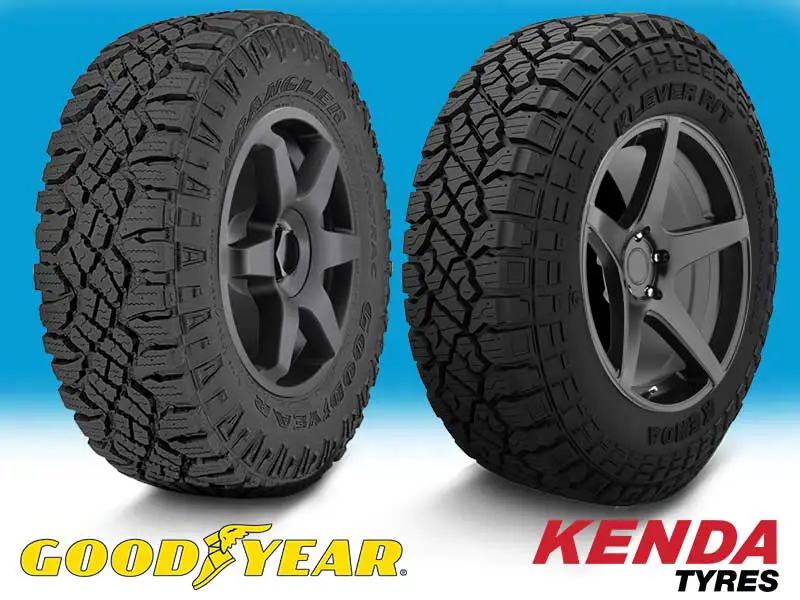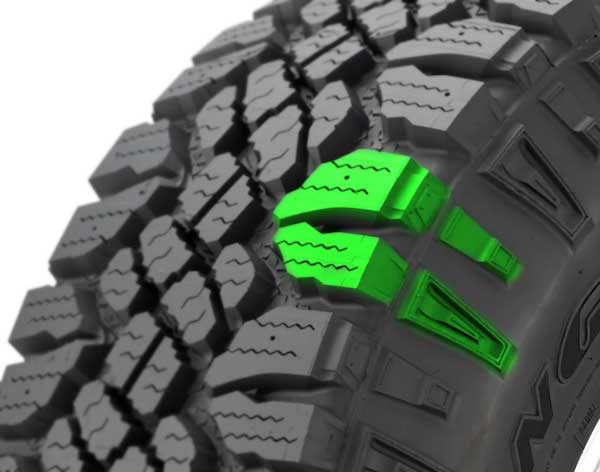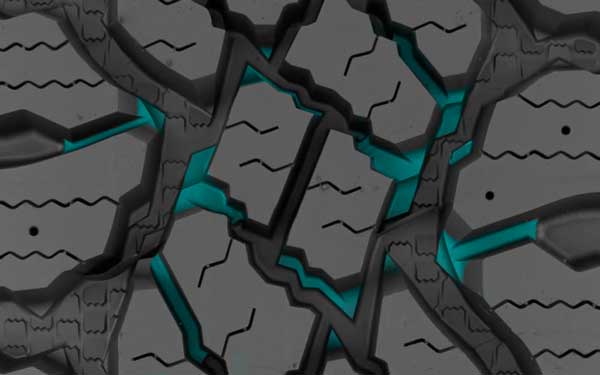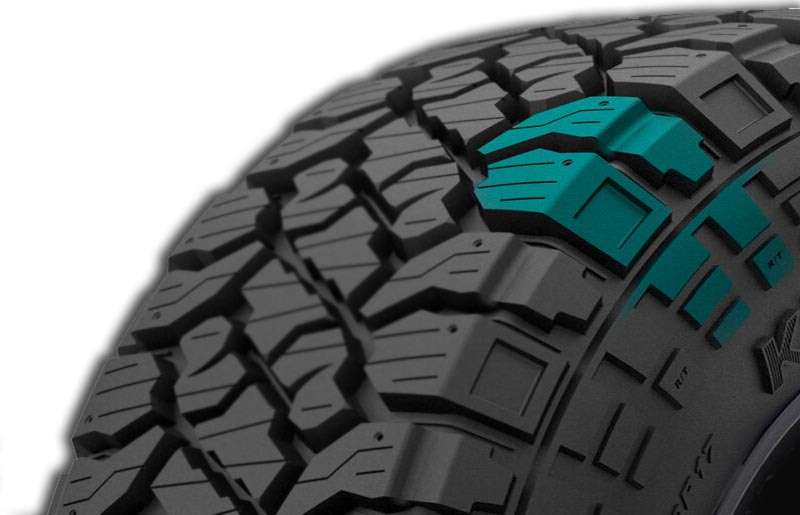Kenda Klever RT vs Goodyear DuraTrac: Both the Kenda Klever RT and the Goodyear Duratrac are hybrid tires, meaning they carry mud terrain like shoulders, while the middle tread area mimics a closed up lug design like seen on all-terrain tires.
Hybrid tires basically offer enhanced off-road performance without compromising too much on highways. These tires are for those, who spend a little more time off-road, compared to pavements.

Examine the treads on these tires closely. They hold the key to knowing which to choose. In fact if you visit my "tread design" page, picking the right tire would never bother you.
Lets check out these tires in detail, though its best if we get the sizes, and their specs, out of the way first.
| Specs | Goodyear Duratrac | Kenda Klever R/T |
|---|---|---|
| Rim Sizes (inches) | 15 to 22 | 15 to 24 |
| Weight Range (lbs) | 35 to 68 | 40 to 80 |
| Speed Rating | Q, S, P, and T | Q and R |
| Load Rating | SL to F | C, D, E, F |
| Tread Depth (32″) | 16 to 18 | 17 or 19 |
| Winter Ratings | 3PMSF and M+S | Only M+S |
| Warranty | 50k miles on P metric sizes | None |
Table of Contents
Tread Design
Looking at the design of these two tires, the Goodyear DuraTrac is characterized by its jagged edges and a variety of shapes and sizes. Let’s consider its shoulder lugs first.

So there are two different designs there. They are staggered with thick mud scoops (although they are not as seen on its counterpart).
Though they make much wider surrounding gaps, though its funny that you still don’t see any stone ejectors in them.
These shoulder blocks are equipped with eave-like siping, stud-holes and reinforced foundations.
Moreover, these blocks also continue onto the sidewalls, creating a unique design of elongated lugs there with deep incisions in them.

The central lugs are smaller in comparison, and have reinforced foundations underneath as shown in them image. All these lugs basically sit on a secondary rubber layer, in other words. And this allows for on-road stability.
These lugs carry a jagged pattern, other than that, along with almost similar wave-like siping, and chamfered edges.
And on their base, there’s a secondary tread pattern, which Goodyear calls Tractive Grooves Technology.
On the other hand, the Kenda Klever RT features a comparatively smoother lug design.
It’s shoulder lugs although are also studable just like the Duratrac, they carry less sharper edges. And yes, they also have relatively smaller gaps surrounding them.

The tire’s central lugs also carry a striking resemblance when compared with Duratrac. Like for example see how Kenda R/T forms 4 independent lugs here, each with a lot of off-set edges and reinforced foundations.
Although these lugs don’t features wave-like siping pattern like its competitor, they do make interconnected web of grooves running all directions.
Moving towards sidewalls…

The tire features staggered shoulders with bigger mud scoops, and its sidewall lugs features more number of biters.
Moreover, unlike the Duratrac, the Kenda Klever R/T also features bold stone ejectors in every lateral shoulder gap.
Dry Road Performance
When it comes to dry performance, there are two things to consider, grip and handling.
In terms of (directional) grip which depends on the central area of the tread, both tires showcase a similar performance (calculated by braking distances).
And looking at their designs it makes sense, since both of these have similar closed up lugs there with reinforced foundations underneath, allowing for decent braking and acceleration efficacy.
Though in terms of lateral traction, the Kenda Klever RT manages to take the lead, despite it having larger structural weight (on average, comparing all sizes).
So why is that the case?
Well, because of two things, one, its relatively stiffer rubber composition, don’t allow its blocks to flex too much, allowing for better under and over steering balance, and two, it’s shoulder blocks are comparatively more closed up together, so they meet with the road with greater consistency.
The Goodyear Duratrac on the other hand, with such wide gaps, don’t allow a good enough shoulder contact and with softer tread, it’s lugs bend a lot more against the road, despite them having solid foundational supports underneath.
(Shoulder lugs get to bear more weight pressure on them, as the tire corners).
Wet Traction
Wet performance is a combination of hydroplaning resistance and wet grip.
Hydroplaning is not an issue for these tires having such wider tread voids, so let just jump on towards the gripping part.
So wet grip comes form sipes, as they offer slits which soak up water particles.
And so it makes sense why Goodyear Duratrac does significantly better.
The tire features better (interlocking) siping structure, which basically don’t get stiff with the tire’s maneuverability. And since the tread composition of Duratrac is already softer, it further adds to the effectiveness of those sipes.
Kenda Klever RT on the other hand, lacks with stiffer compound and only rectilinear siping structure (which don’t breath water particles as effectively).
Off Road Performance
Off-road both tires do pretty great. Though when you put durability in the overall equation, things change very quickly.
On Rocks
Rocky terrains are where most punctures happen, particularly on the sidewalls, and so Kenda Klever RT, with 3 ply polyester carcass, get to be superior here overall.
Moreover, the tire also features thicker sidewall lugs, which supply greater climbing efficacy, despite its having a heavier overall structure.
But other than that, the Goodyear Duratrac offers similar biting efficacy. In-fact, on wet rocks it features superior lateral traction, where Kenda Klever RT would mostly slip.
Muddy Terrains
On mud, you need two things on the tread. Paddles, and self cleaning grooves. And considering both, although its by a small margin, the Goodyear Duratrac features superior performance.
It’s wider circumferential groove rings surrounding shoulder blocks simply allow better pathway for the thick mud to leave out quickly.
While its sharp zigzag blocks edges, and Tractive Groove Technology, breakdown the mud particles, so they can escape out with much more ease.
The Kenda Klever R/T although has the advantage of bigger mud scoops, which supply with superior forward moving inertia, it’s central interlocking lugs aren’t as efficient in evacuation the mud out of the tread.
Sandy Dunes
Sand is a terrain, where you always lower the tire’s air pressure, but why is that?
Well, because this basically enhances the tire’s footprint with the sand, and gives it better floating abilities, this is better, because sinking in the sand is the recipe for disaster.
So having said that, it can be seen why the Kenda Klever R/T takes away the show here.
It although features a heavier weight, which should technically sink in more, it’s sidewall lugs spread out in a better way with reduced air pressure, and allow for better flotation, and with it traction.
Snowy Performance
On snowy terrains, the Goodyear Duratrac does considerably better, which is not a surprise, as this tire is the only one here, with 3 Peak Mountain Snowflake rating along with M+S.
The tire basically carries all the features which are usually seen on dedicated winter tires, which Kenda Klever R/T is missing, so it gets to be significantly better.
These features include, having a skinnier section width on average, more biters that are capable of holding up the snow, and a softer rubber, which remains flexible at all times.
With skinnier design, the Goodyear Duratrac puts more pressure on the snow, while it’s Tractive Grooves along with sipes, and biters hold on the snow particles lodging them in the grooves.
These stuck up snow particles, then form snow contact with the ground, to produce much better results (as snow to snow contact generates greater frictional forces, compared to rubber to snow exposure).
The Kenda Klever R/T lacks here due to its reduced snow contact forming abilities. Moreover, its stiffer compound is not that thermal adaptive, meaning they don’t stay flexible with freezing temperatures.
Though I like the option of adding studs on this tire, just like the Duratrac.
Tread Life and Fuel Economy
Both tread life and fuel are closely related to each other, as they both depend upon the tire’s weight, tread compound composition and tread depth.
And looking at these factors, it can be seen why Goodyear Duratrac, although does better with fuel, lacks in providing as much mileage as its counterpart.
The Kenda Klever R/T is although a heavier tire here, it still features a stiffer rubber with greater tread depth on average.
With a harder rubber compound, its tread is more resistive to burning off faster, while its deeper tread voids would means it would take longer to burn down to the replacement levels.
That’s why Goodyear Duratrac with softer compound and shallower tread depth, basically having the exact opposite case, gets to be lacking here.
Though the tire with lighter construction, still gets to exert smaller pressure on the lugs, as the rub against the road, decreasing overall rolling resistance and with it fuel.
Verdict?
So it all comes down to this.
The Kenda Klever RT gets to be better on dry roads, in terms of handling and grip, with it’s stiffer rubber, and closed up tread voids.
Whereas the Goodyear Duratrac with better siping structure delivers better wet and snow traction (the tire is also rated with 3PMSF unlike its counterpart).
Moreover, the tire also does well in the fuel efficiency, though it lacks to Kenda in terms of providing greater tread life.
Off-road, the Kenda Klever R/T does well on rocks and sand, whereas Duratrac is a better pick for muddy trails.
